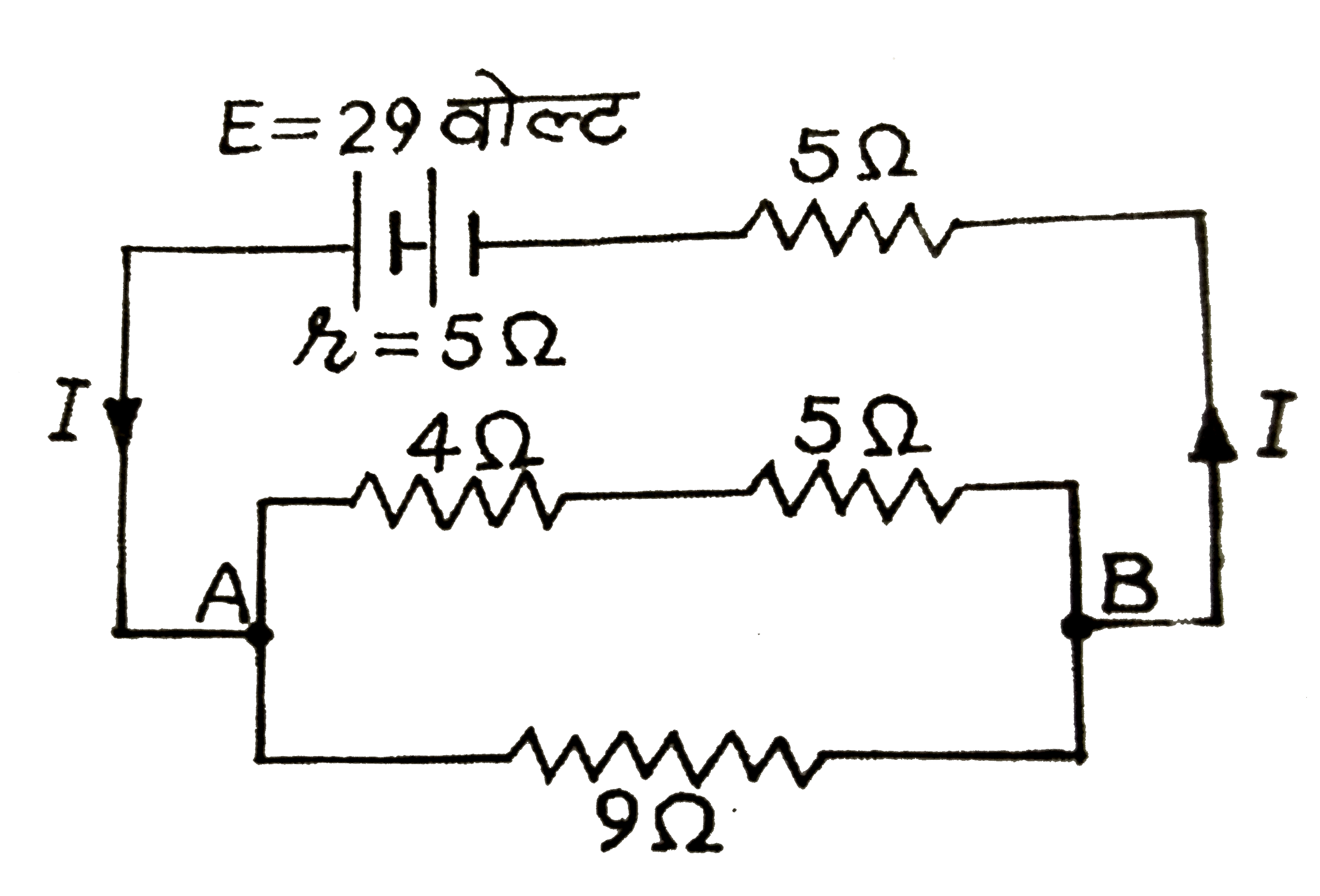From the given circuit
Find
(i) Equivalent emf
(ii) Equivalent internal resistance
(iii) Total current (I)
(iv) Potential difference across each cell
(v) Current from each cell
 Solution in Tamil
Solution in Tamil
(i) Equivalent emf ξeq=5V
(ii) Equivalent internal resistance,
Req=rn=0.54=0.125Ω
(iii) Total current, I=ξR+r/n⇒I=510+0.125=510.125
⇒I=0.5A
(iv) Potential difference across each cell, V=IR=0.5×10=5V
(v) Current from each cell,
I.=In⇒I.=0.54=0.125A
Topper's Solved these Questions
- CURRENT ELECTRICITYBOOK - FULL MARKSCHAPTER - CURRENT ELECTRICITYEXERCISE - TEXTBOOK EVALUATION (Choose the correct answer)
15 Videos
- CURRENT ELECTRICITYBOOK - FULL MARKSCHAPTER - CURRENT ELECTRICITYEXERCISE - TEXTBOOK EVALUATION (Short Answer Questions)
21 Videos
- COMMUNICATION SYSTEMSBOOK - FULL MARKSCHAPTER - COMMUNICATION SYSTEMSEXERCISE - ADDITIONAL QUESTIONS (Additional problems)
3 Videos
- DUAL NATURE OF RADIATION AND MATTERBOOK - FULL MARKSCHAPTER - DUAL NATURE OF RADIATION AND MATTEREXERCISE - ADDITIONAL QUESTIONS -( ADDITIONAL NUMERICAL PROBLEMS : )
10 Videos
Similar Questions
The following graph shows current versus voltage values of some unknown conductor. What is the resistance of this conductor?

View SolutionWhy current is a scalar?
View SolutionA radio can tune into any station in the 7.5 MHz to 12 MHz band. What is the corresponding wavelength band ?
View SolutionIf a light of wavelength 4950 Å is viewed as a continuous flow of photons, what is the energy of each photon in eV ? (Given h=6.6×10−34Js, c =3×108ms−1)
View SolutionIn the given circuit , the potential difference across the capacitor is 12 V. Each resistance is of 3Ω. The cell is ideal. The emf of the cell is

View SolutionPotential differences across the terminals of a cell were measured (in volt) against different currents (in ampere) flowing through the cell. A graph was drawn which was a straight line ABC as shown in figure Determine from graph (i) emf of the cell (ii) maximum current obtained from the cell and (iii) internal resistance of the cell.
View Solution
For a cell the graph between the p.d. (v) across the terminals of the cells and the current (I) drawn from the cell as shown. The emf and internal resistance is
View Solution(a) Find the potential difference between A and B

(b) Calculate the current flowing in the circuit and the potential difference across terminals of each cell.

( c) Calculate the potential difference across terminals of each cell.

(d) Calculate the potential difference between A and B

( e) Calculate the current in each resistor and terminal potential difference across each cell.

(f) Calculate potential difference across each cell.

(g) A battery of 6 cells each of emf 2V and internal resistance 0.5Ω is being changed by DC mains of emf 220V by using an external resistance of 10Ω. Calculate.
(i) the charging current
(ii) the potential difference across the battery.
 .
.
View SolutionThe potential difference across a cell is 1.8 V when a current of 0.5 A is drawn from it. The p.d. falls to 1.6 V when a current of 1.0 A is drawn. Find the emf and the internal resistance of the cell.
View SolutionIn the circuit diagram given alongside, find:
(i) total resistance of the circuit,
(ii) total current flowing in the circuit, and
(iii) the potential difference across R1

View SolutionIn the figure each cell has an emf of 1.5 V and internal resistnce of 0.40Ω Calculate :

(i) current I
(ii) potential differnce across A and B.
View Solutionदिए गए परिपथ में ज्ञात कीजिए
- (i ) परिपथ का तुल्य प्रतिरोध , (ii ) परिपथ में धारा
View Solutionसंलग्न विद्युत् परिपथ में सेल का आन्तरिक प्रतिरोध 1Q है तथा विद्युत् वाहक बल 20 वोल्ट है। ज्ञात कीजिए-(i) परिपथ का सम्पूर्ण प्रतिरोध, (ii) परिपथ की धारा (I) तथा (iii) बिन्दुओं A व B के बीच विभवान्तर।

View Solutionदिये गये वैधुत परिपथ में सेल का आन्तरिक प्रतिरोध 5 ओम है तथा वि० वा ० बल 29 वोल्ट है ज्ञात कीजिये : (i ) परिपथ का सम्पूर्ण प्रतिरोध (ii ) परिपथ की धारा ,(iii ) बिन्दुओ A व B के बीच विभान्तर ।

View SolutionTwo capacitors of capacitances C_1 = 6muF and C_2 = 3muF are connected in series across a cell of emf 18 V. Calculate (i) the equivalent capacitance, (ii) the potential difference across each capacitor, (iii) the charge on each capacitor.
View Solution
